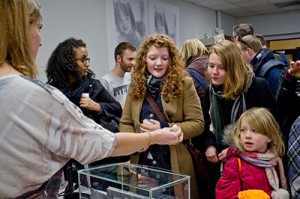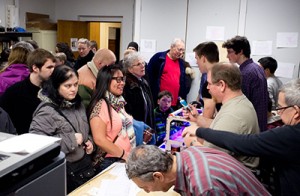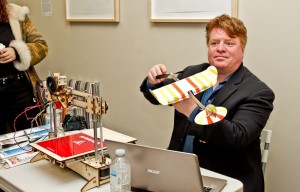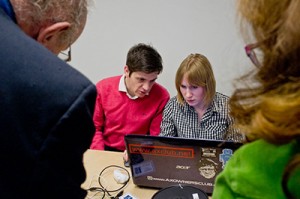Saturday Artengine hosted a 3D Print-a-thon, to celebrate the Lab’s 2 new machines, The Ultimakers, and get the community inspired by inviting the region’s best 3D print enthusiasts to bring their machines, their designs, and their expertise to share with all comers. The M70 Lab was crushingly packed all day with over 400 people passing through, Ottawans of all ages interested in learning and shop-talking about this technology, and seeing it in action. The growing availability of 3D printing technology is exciting because it has the potential to be as transformational as the invention of the personal computer, automobile or even printing press; and it seems to have the fastest adoption rate of such a tool in history.
As experienced printers like Andrew Plumb were on the scene to explain why interest in 3D printing is growing into a tidal wave. Plumb recently stepped down as the moderator of the 3D printing enthusiast webgroups MakerBot and Thingiverse, a role he had held for the past four years, because the huge increase in new owners of these machines was keeping him so busy with the groups he didn’t have time for his own designing and printing anymore. But as this wave of interest is cresting, it has accelerated the technology in ways that in most cases, make it sound better and better.
WHAT IS IT
In traditional manufacturing, or sculpture, an object is usually created using one of two processes: pouring material in to a mould to make the shape you want, or taking a solid block of material and chipping away or machining away bits of it until what remains is the object you want.
3D printing differs from the latter in that it is additive, not subtractive; it builds the object by adding and fusing tiny amounts of bulk material to each other until the object is formed; it differs from the former in that each object is made one at a time. An additive process means there is much less waste, and a one-at-a-time process means that economies of scale do not apply.
The technology was invented for prototyping, but has other fantastic applications. The medical industry has used it, in the creation of moulds for crowns or bridges and surgical guides by dentists; most new in-ear hearing aids are custom printed; a woman in the Netherlands has a replacement jaw produced by a 3D printer.
A favourite is the ability to fashion replacement parts for existing appliances and machines that are rendered useless when one small component is damaged, and no replacement is available for purchase. The mass of objects on earth which are 90% good but 100% unusable due to that 10% which is broken or worn must be enormous. This also cheers the part of me which is suspicious of planned obsolescence; with the means to replace dodgy parts in the hands of consumers, any benefit to the producers of certain products which might contain such weaknesses would be reduced.
A lot of the demonstrated creative uses of home 3D printing are small plastic items. My first reaction to the technology was an internet search thread on the proliferation of plastics which seemed to lead inevitably to the Great Pacific Garbage Patch, the largest of several collections of plastic waste which have accumulated in the oceans of the world, consolidated in areas where currents carry them. My searches turned up some promising news about this blight on our ecosystem, as did my visit to Artengine’s Print-a-thon.
Patricia Pichette, who shares an interest in 3D printing with her husband James Allenson, produces jewellery through her company Fused Elements. She explained to me that her products are made with a material that is 100% biodegradable. She uses software like Futurescape, a user-friendly art software similar to Photoshop which lets users choose shapes and modify them until they have the design they want, or Rhino, which comes with an optional plugin RinoGold, specifically designed for users working with precious metals.
Their biodegradable material is one of a very a long and growing list of materials usable with various 3D printers. The typical plastic material comes in a spool of one kilogram and costs about $50. But besides the many types of plastic which can be used, 3D printers can make things out of paraffins, resins, waxes, glass or sand, metal powders, concrete, ceramics, paper, and even food, including chocolate.
The cost of 3D printing is already comparable to the cost of injection moulding for runs of more than 1,000 items. It is increasingly scalable, which can only mean more independent producers feeling less risk in experimenting with new products, as the cost of prototyping is vastly reduced, and their ability to scale manufacturing to demand increases. And with the price tag for small household printers dropping below the $1000 mark, the technology is spreading fast.
BENEFITS, AND CONCERNS
The potential benefits of 3D printing go far beyond what I’ve explained already. The ability to do manufacturing anywhere you can plug in a printer means huge savings in the costs of transporting huge amounts of product. You could soon order something online that’s designed by a company halfway around the world, and then walk down to the post office where they will print it for you. Some say these savings will be wiped out by the huge increase in the time it takes to make a product by printing. But in an economy where many find themselves increasingly time rich and cash poor, this may not bother many people.
Produced on demand means no more unsold stock, sitting in warehouses, until it’s back in season like patio furniture, or forever if it will never be back in style. The downside to this for some is a possible decrease in the frequency of bargain basement prices, when retailers sell stock at a loss they can’t get a profit from.
The additive process means much less wasted materials in production. No more tail-ends or shavings from products cut or machined out of larger pieces.
The potential for vastly increased life of products with many parts which might previously have gone out of production, such as automobiles, is very encouraging, but has a downside. A study at the University of Colorado showed that while gasoline consumption has tripled in Los Angeles since the 1960s, emissions are down 98 percent. Half of that decrease in emissions has occurred since 2002. So keeping old cars on the road, or old refrigerators and other consumer machines running, means putting up with their lower efficiency and much greater capacity to pollute.
Still, most 3D print enthusiasts are of a heavily environmental persuasion, like Envirolaser, an Ottawa company who brought one of the many 3D printers they sell to the event. Envirolaser has an excellent reputation in Ottawa as promoters of environmentally friendly solutions to new technologies that make good economic sense, starting with laser printers in 1991.
In fact the machines, by nature of their potential to transform manufacturing in environmentally friendly ways, and their hands-on anything goes simplicity in engineering and design, uniquely attract environmentalists with plenty of ingenuity. One example is Markus Kayser, a designer who studied in London and at MIT, has invented the SolarSinter, designed to be used in the desert, a 3D Printer powered by the sun that can transform sand 3D printed glass objects. Another is Ben Chapman, a promoter of ‘upcycling’, or finding new uses for commonplace objects. He’s developing a design for a 3D printable sled that transforms an unwanted ceramic mug into a knife sharpener.
Other concerns about 3D printing include the loss of jobs in a less labour-intensive manufacturing process. 3D printers can already produce complex shapes which would be impossible with with moulds or machining. The Intellectual Property concerns are also alarming; just as music and movies can be digitized, swapped, and pirated, so too could any design contained in 3D printing code.
And the dangers of some of the plastics 3D printers use are still poorly understood. These plastics can contain or absorb pollutants and toxins, like Bisphenol A, DDT, and PCBs, and carry them up the food chain. Plastic photodegradation in the ocean causes the materials to break down to the molecular level, while still remaining polymers, that have been shown to disrupt endocrine receptors in humans and animals. Samples of some areas of the ocean have shown the concentration of plastics to be seven times that of zooplankton. Objet, a 3D printing service provider, offers a menu of over 110 different materials in which they can print your design, including many forms of plastics. It’s difficult to imagine that while 3D printing will reduce the amount of plastic consumed in manufacturing, it won’t also promote it’s production and consumption as well.
However, a team at the University of Washington in Seattle recently developed a new material from sugar, maltodextrin, and ceramic which anyone can mix in their home for less that $2 a kilogram. And it is biodegradable. In the world of 3D printing, the technology moves so quickly it’s difficult to keep up.
The 3Doodler is recently developed a hand-held pen which extrudes hot plastic, allowing for a kind of freehand 3D printing which doesn’t even require a computer. Like several of the 3D printer development companies, the developers of the 3Doodler have launched their project on Kickstarter, an online crowd-funding resource tool. With 19 days to go, they have exceeded their $30,000 goal by $2,029,169. 22,072 people have contributed $75 or more to the project guaranteeing them their very own 3Doodler and bags of plastic. The ABS plastic that comes with the toy is described
on their website as “classed under recycling number 7”, which is the category of most difficult to recycle and most likely to contain toxins of any plastics class. They offer biodegradable PLA plastic for “the most ardently eco-friendly 3Doodlers”. Their explanation of the safety of the ABS they use is not convincing. It will be a great shame if enthusiasts like these manage to dominate the public’s imagination and the marketplace, as the 3Doodler clearly has with its exciting success story.
Another development in the rapid history of 3D printing adoption has been the desire of some to share designs for producing weapons with the machines. Cory Wilson, a law student in Texas has started a fundraising group called Defense Distributed, in an attempt to raise money to develop a fully printable weapon capable of firing a round, and release the code to anyone who wants it. This project makes my stomach turn because although people have been making handguns at home forever out of any material they can find; making guns for personal use is not usually illegal. The project has already developed and successfully tested a 3D printed plastic magazine for the terrifying and popular AR-15 assault rifle capable of carrying 30 bullets, in defiance of legislation banning magazines with a capacity larger than 7. A U.S. Congressman plans to table a bill to ban any guns undetectable to conventional scanners, in fear of the possibility of a completely plastic firearm, although such a weapon would be very difficult to design and build.
IN THE ART WORLD
Of course this technology has been quickly embraced by creative people with purely artistic aims, excited at the prospect of a huge increase in the possibilities of what one person in their home can create, on a budget which hitherto would have made manufacturing the smallest trinket impossible.
Fine art’s leanings, since the 1960s, towards design, were a preamble to this new age where art can be about engineering, too. And every day we use devices that are more and more alien and unbelievable, in their ability to transform our own imaginations with their functional problem-solving abilities.
Artists have been early adopters and proponents of this technology, and the intersection of 3D and art has produced mixed results.
Eyal Gever creates 3D printed recreations of disasters like floods, or semitrailer crashes, in flashy colours. His art reminds me of one thing I find depressing about 3D printed art: the lack of detail in so much of it. This article celebrates the incredible detail these machines can make; I don’t see it yet. When I look at these works it is the lack of detail that impresses on me. A single brush stroke has more detail in. The evidence of human intervention in these works isn’t strong enough either intellectually, or viscerally.
Cosmo Wenman is an artist who uses 3D printing to create reproductions of works he photographed in the British Museum. A technology that allows users to create the code of a 3d printable design using only photographs of the object exists already. He paints the plastic replicas and finishes them to look exactly like the aged bronze or marble originals. It’s a sort of antithesis to the popular art of Jeff Koons of Mark Grotjahn, who reproduce cheaply made objects in expensive materials.
Michael Hansmeyer makes works using 3d printing design principles on computer, which explode with detail and math that sings in your head. His work, to me, is a strong example of the creative possibilities on the design side of 3D printing. With a computer fully integrated in the process, it seems to me the most likely area for true creativity, rather than replication of shapes familiar to us from the days of molding and machining, is in the illustration of mathematical concepts in a tangible work of sculptural art, or the creation of tangible works with more intentional detail and complexity than previously available.
This article shows works by two European artists with unique approaches to 3D design that make the printers seem worth having. Matthew Plummer-Fernandezcreates household objects like a vase or teapot, with a mathematically chisled exterior that has the weird familiarity of low-resolution internet pixelation. The results are divine. Frederik de Wilde creates 3D rendering of the layouts of mines. They don’t look that impressive but the concept feels like it holds promise.
In the tradition of Vancouver craft artist Wendy Tsao, who brings children’s doodles to life in custom-made stuffed toys, Cunicode, a 3D printing design studio, has created CrayonCreatures.com, a service for designing and printing custom 3d figurines out of children’s doodles.
In Japan you can go into a booth which scans your whole body and creates a scale figurine, in full colour, of you. The company’s website shows they are experiencing delays due to unexpected demand for the figurines which range from $250-$400 each. This concept is quickly proliferating around the globe.
LATEST DEVELOPMENTS IN THE TECHNOLOGY
The most worrisome part of 3D printing being the potentially toxic plastic, for me, makes me feel very encouraged by two emerging technologies. The first is Filabot Reclaimer, a device currently in development it’s creators say will enable 3D printers to grind up all sorts of household plastic refuse, and fuse it together for use as filament or raw material for their 3d printing projects. Due to the complexity of sorting different plastics I’m skeptical of this project, but they seem to think they can do it, and if so this is a wonderful development. I suppose it might encourage enthusiasts to buy more heavily-packaged food at the grocery store, but the idea behind Filabot is worth the risk. This TED talk by Mike Biddle explains some of the difficulties in sorting plastics.
The other is a British company, Metalisys, has developed a technique of perofrming electrolysis on powdered metal oxides to produce expensive metals like titanium and tantalum at a fraction of the current price. This could be a huge boost to countless industries. According to The Economist, a reduction of 1kg in the weight of an airliner would save around $3,000-worth of fuel a year and by the same token cut carbon-dioxide emissions. Replacing steel parts with titanium (which is 5% weaker, but 40% lighter and more resistant to corrosion, abrasion, and temperature) would certainly do that. If the price of these powdered metals can sink low enough, they may be able to overtake the plastics that overtook them decades ago, and I’ll be able to sleep at night.
Medical uses of 3D printing are surging ahead, with new implant designs that mimic actual lattice bone structure to encourage bones to grow right on to the implant, to fuse with it. And the complex structures that 3D printers can generate, and machining can’t, means greater strength and flexibility in components, make every kind of machine imaginable more efficient, safer and longer lasting.
And of course, this article wouldn’t be finished if I didn’t answer the question you are all asking, “Is there a 3D printer that prints 3D printers?” The answer is yes, read about it here…
The most promising sign for the future of 3D printing, however, has to be Fabrika 3D Printing Services, a group of Ottawa highschool students who had a table at the 3D print-a-thon. These whiz kids have built the custom designing and printing business around an ingenious signature product, an iPhone shell case which has space for a student card, customized to display the barcode and photo. The student can use the card without ever taking it out of the case. Most importantly it’s written clearly on their website that they only use bio-degradable plastic from a renewable source. With such young entrepreneurs showing they understand the values of their generation well, the future looks bright for all.
Don’t miss the next Artengine Mod Lab event!
photo credit @Zara Ansar
Tags: 3D Printing, Lab, ModLab, new equipment







